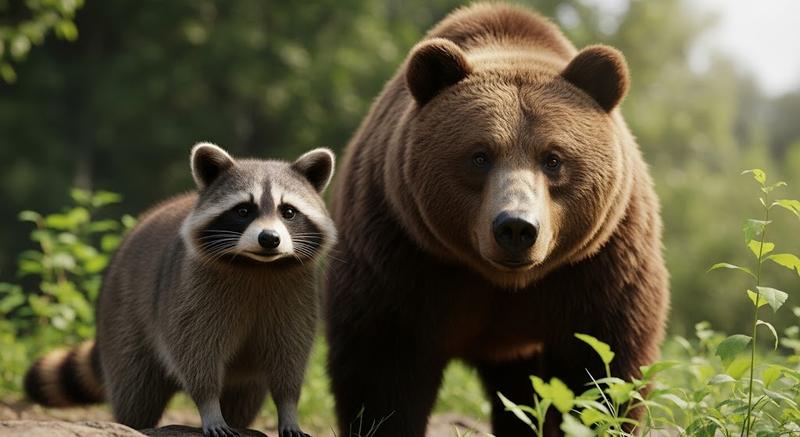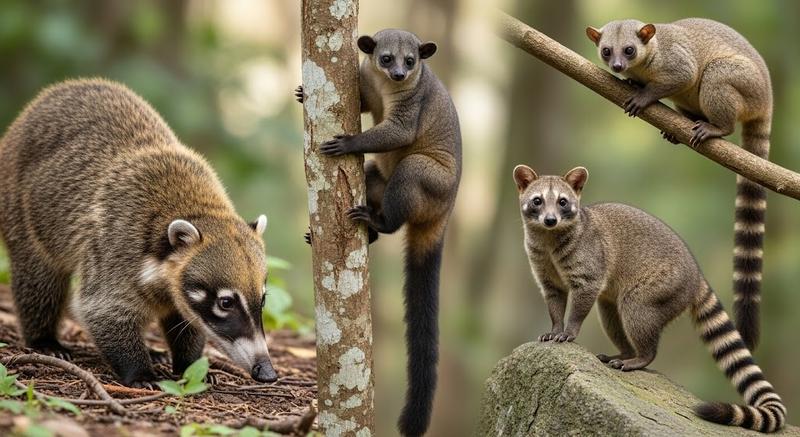Are Raccoons Related to Bears? The Evolutionary Truth Explained

No, raccoons are not directly related to bears, though they share a distant common ancestor. Both animals belong to Carnivora, but raccoons are part of the Procyonidae family while bears fall under Ursidae. Despite some visual similarities, their evolutionary paths diverged millions of years ago.
Animal family tree: Where do raccoons and bears fit?
Raccoons and bears both belong to the biological order Carnivora, a large group that includes dogs, cats, weasels, and more. However, they part ways at the family level. Bears belong to the Ursidae family, while raccoons are part of Procyonidae. This distinction means that although they’re both “carnivores” in a scientific sense, they are no more related than distant cousins who live in the same city.
Here’s how they compare taxonomically:
|
Classification Level |
Raccoon (Procyon lotor) |
Bear (Ursus arctos, etc.) |
|
Kingdom |
Animalia |
Animalia |
|
Phylum |
Chordata |
Chordata |
|
Class |
Mammalia |
Mammalia |
|
Order |
Carnivora |
Carnivora |
|
Suborder |
Caniformia |
Caniformia |
|
Family |
Procyonidae |
Ursidae |
So while raccoons and bears share some taxonomic levels, their evolutionary paths diverged significantly at the family level.
How closely related are they? Understanding their evolutionary split
Raccoons and bears last shared a common ancestor over 40 million years ago, during the early evolution of carnivorous mammals. From that point, bears began evolving into large, omnivorous creatures suited to colder climates and solitary lifestyles. Meanwhile, raccoons developed traits that made them adaptable to various environments, especially woodlands and urban areas.
Both animals fall under the suborder Caniformia, also known as the “dog-like” carnivores, which includes wolves, foxes, and skunks. Within that group, raccoons are part of the Musteloidea superfamily, meaning they are genetically closer to skunks and weasels than to bears.
What traits do raccoons and bears share?
Even though they aren’t closely related, raccoons and bears have evolved similar features due to their shared environment and diet. This phenomenon is called convergent evolution—when unrelated species develop similar traits to adapt to similar challenges.
Common traits include:
-
Omnivorous diet: Both eat a mix of plants, fruits, insects, small animals, and human food when available.
-
Dexterous paws: Useful for foraging, opening containers, and manipulating food.
-
Strong sense of smell: Crucial for locating food sources, especially at night.
-
Physical appearance: Rounded ears, thick fur, and stout bodies that may look similar at a glance.
Despite these shared traits, their behaviors, intelligence levels, and ecological roles differ considerably.
What animals are raccoons actually most related to?

While bears are large omnivores often found in forests and mountains, raccoons are part of a very different evolutionary group: the Procyonidae family. Their closest relatives include:
-
Coatis: Long-snouted foragers found in Central and South America.
-
Kinkajous: Arboreal animals with prehensile tails.
-
Olingos and olinguitos: Rare, tree-dwelling mammals.
-
Ringtails: Small, fox-like mammals native to North America.
All these animals share behavioral and anatomical traits with raccoons, such as tree-climbing ability, omnivorous diets, and nocturnal habits.
The red panda is a unique case. Due to their ringed tails and climbing habits, they were once grouped with raccoons, but they are now placed in their own family (Ailuridae), although they still share more genetic similarities with raccoons than with bears.
To see how these close relatives compare visually, you can explore our guide to animals that look like raccoons.
Why do people think raccoons are related to bears?
This misconception likely stems from visual and behavioral similarities rather than scientific evidence. Here’s why many think raccoons are baby bears:
-
Body shape and fur: Both animals are furry, rounded, and walk on all fours.
-
Diet: Both are omnivores with opportunistic feeding habits.
-
Behavior: Raccoons standing on hind legs or rummaging through trash resemble young bears.
-
Pop culture: Nicknames like "trash panda" and "baby bear" reinforce the idea in memes and social media posts.
However, these are superficial comparisons. The underlying genetics and taxonomy clearly separate raccoons from bears.
FAQs - Are Raccoons Related to Bears?
How closely are raccoons and bears related?
Raccoons and bears are distant relatives that share a common ancestor roughly 40–50 million years ago. Both belong to the suborder Caniformia (“dog-like” carnivores), which also includes dogs, wolves, weasels, and skunks.
Here’s how they split:
-
Order: Carnivora
-
Suborder: Caniformia
-
➡️ Raccoons branch into Procyonidae
-
➡️ Bears diverge into Ursidae
Although they look similar at a glance and share some behaviors (like foraging and opportunistic eating), their genetic makeup, ecological roles, and evolutionary paths differ significantly.
This phenomenon—when unrelated species evolve similar traits due to similar environments—is called convergent evolution.
Is the red panda related to bears or raccoons?
The red panda was once classified as a relative of raccoons due to its ringed tail and arboreal lifestyle, but modern genetic studies have placed it in its own unique family: Ailuridae.
So, to be clear:
-
The red panda is not a bear (Ursidae).
-
It's also not a raccoon (Procyonidae).
-
It belongs to Ailuridae, although it shares a common ancestor with both groups through the Musteloidea superfamily.
Despite the name and appearance, red pandas are a distinct evolutionary branch and are more closely related to skunks and weasels than to bears.
While the red panda isn't a bear or a raccoon, many people also mistakenly wonder if a raccoon is a rodent.
Are raccoons part of the bear family?
No, raccoons are not part of the bear family. While both raccoons and bears belong to the order Carnivora, raccoons are members of the family Procyonidae, whereas bears are in the family Ursidae.
The confusion often arises because raccoons share certain traits with bears — such as a stocky build, omnivorous diet, and foraging behavior — but genetically and taxonomically, they are not bears. In fact, raccoons are more closely related to coatis, kinkajous, and ringtails than to any bear species.
Final thoughts: What makes raccoons unique in the animal kingdom?
Raccoons may look like small bears, but their story is quite different. These intelligent, adaptable mammals thrive in diverse habitats, from deep forests to city streets. Unlike bears, raccoons are social, curious, and highly skilled with their paws.
Think of raccoons and bears as distant cousins: same neighborhood (Carnivora), different households (Procyonidae vs Ursidae).
Raccoons aren’t baby bears. They’re clever survivors with their own evolutionary legacy.
Now that you understand the raccoon's unique heritage, you can celebrate what makes them truly special. Forget the 'baby bear' nickname and embrace their authentic charm. Find a style that honors their one-of-a-kind identity in our Raccoon Aesthetic Outfit collection, or browse our funny animal shirts for a more playful take.
Recent Posts
- How Long Can Raccoons Survive Without Food or Water?
- How Long Do Raccoons Live? Wild vs Captive Lifespans Explained
- Are Raccoons Marsupials? Here's the Truth Behind the Confusion
- Is a Raccoon a Rodent? The Truth About Their Classification
- 15 Animals That Look Like Raccoons and What Makes Them So Similar
- What Are Raccoons Good For? 4 Surprising Benefits You Should Know
- What’s a Group of Raccoons Called? Fun Facts & Rare Terms
- 20 Fun Facts About Raccoons That'll Surprise You
- Return Policy for Clothing Online: What You Need to Know
- How to Check the Quality of a T-Shirt Before Buying (2025 Guide)

